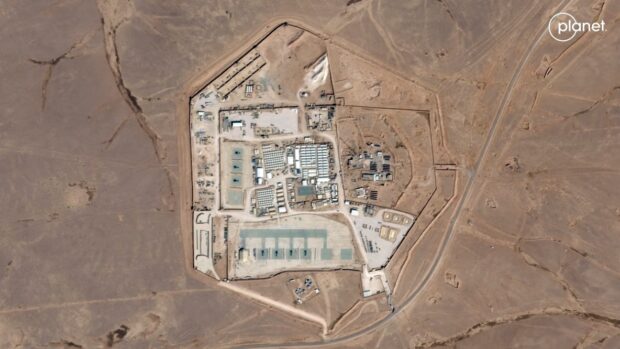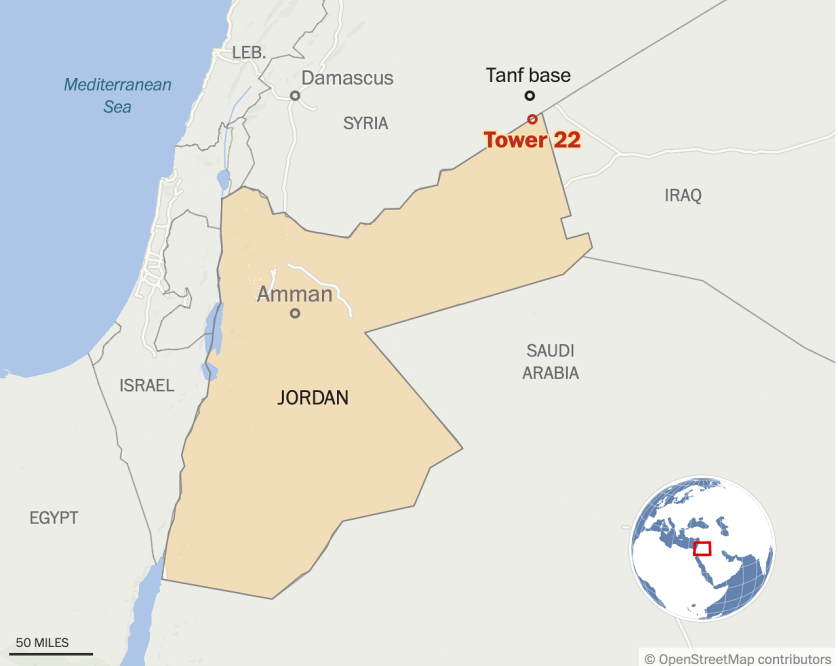U.S. forces probably did not detect the approach of the Iranian-made drone that killed three American soldiers last week at a remote base in Jordan, and there was no air defense system on site capable of shooting it down, the military’s initial assessment of the attack has found.
The early findings, which have not been previously reported, indicate that the drone may have been missed “due to its low flight path,” a U.S. defense official with direct knowledge of the assessment told The Washington Post. Additionally, this person said, the base, known as Tower 22, was not outfitted with weapons that can “kill” aerial threats like drones, and instead relied on electronic warfare systems designed to disable them or disrupt their path to a target.
A common strategy among drone operators and other pilots seeking to minimize or evade radar detection is to fly low to the ground. Another U.S. official affirmed the military’s belief that the drone flew too low to be detected. Both officials, like some others, spoke on the condition of anonymity to discuss a sensitive and ongoing investigation. Defense officials have stressed that assessments can change as investigators learn more.
Taken together, the preliminary findings appear to undermine previous assertions that U.S. air defenses mistook the attacking aircraft for an American drone returning to the base about the same time, and they raise new questions about the Pentagon’s ability to keep pace with the threats facing U.S. personnel deployed across the Middle East since the war in Gaza set off an acceleration of violence.
U.S. Central Command, which oversees military activity throughout the region, has declined to say whether officials believe the militants responsible had knowledge of the base’s limited defenses.
In a statement, Pentagon spokeswoman Sabrina Singh said Central Command continues to review the attack.
“For operations security reasons, we won’t discuss specific force protection measures or potential posture changes,” she said. “However, as always, we are committed to taking necessary measures to safeguard our forces [who serve] in harm’s way.”
Tower 22 is located at the nexus of Jordan’s shared border with Syria and Iraq. It functions as a support site for another U.S. outpost, the isolated Tanf garrison in Syria, situated along a key highway connecting Tehran to Damascus. From Tanf, U.S. forces have sought to disrupt Iran’s efforts to supply weapons and materiel to partners and proxies in Syria and beyond.
Location of the Attack
Although Tower 22 was outfitted with “multiple” electronic warfare systems capable of taking drones offline, it had limited means to protect itself. The defense official with direct knowledge of the military’s early assessment said the outpost was deemed a relatively low-threat environment.
“This was based on the vast majority of the threats and 99 percent of the [Iranian-proxy] attacks being against facilities in Iraq and Syria,”
the official told The Post.
The containerised housing structures at Tower 22 appear to be the standard units typically found at U.S. facilities overseas. They are made of relatively thin metal that is not designed to withstand blasts on their own, and can be easily identified on commercial satellite imagery and services such as Google Maps.
Officials have not said whether protection was installed above the units before the attack. Concrete barriers positioned on the ground among the housing units did help to mitigate the explosion, officials said.Earlier threat assessments that concluded Tower 22 faced a lower risk of attack meant the base appeared not to have been
“outfitted with other active countermeasures similar to what other locations across the region had been,”
said Paul Lushenko, an assistant professor and director of special operations at the U.S. Army War College who has studied and written about drone warfare.
Source: The Washington Post


